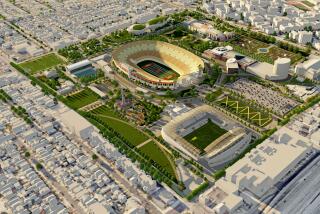A World Expo flop by the U.S.
- Share via
Seeing a statue of Rachel Carson, the crusading American environmentalist, at the World Expo in Shanghai moved me almost to tears. After all, Carson is a symbol of independent thought and action, both vital U.S. exports.
Too bad the statue wasn’t at the U.S. pavilion. But that building, sponsored in part by Carson’s nemesis, Dow Chemical, was never going to be a celebration of the power of individuals. Indeed, the pavilion, with its bland tribute to “community,” says little about what makes America, and Americans, special.
If you think the U.S. message in Shanghai this summer doesn’t matter, you’re wrong. More than 70 million people, most of them Chinese, are expected to attend the Expo (an event that, in size and cost, makes the Beijing Olympics look like a Little League tournament). How the countries of the world present themselves will influence how China views them — with political, cultural and economic consequences far into the future.
Given the high stakes, nearly 200 nations turned out for the Expo. The hits include Britain’s pavilion, which celebrates biodiversity with a gorgeous building housing thousands of seeds, and Switzerland’s, with its exhilarating chairlift ride through an artificial Alp. Some of the national pavilions are educational; others are just plain fun.
But the U.S. pavilion, which is neither, might as well have been across the Huangpu River in the Expo’s corporate section.
The cause is a 1990s law that restricts federal funding for international expositions. This silly bit of isolationism meant the pavilion had to be built by a nonprofit group and given to the U.S. as a gift. State governments were asked to contribute to the nonprofit, but only three — Texas, Tennessee and Hawaii — came through. As a result, there’s a map in the lobby that leaves 47 states unidentified — an appalling symbol of disunity. (Chicago and San Antonio also contributed.)
The other donors were corporations. Secretary of State Hillary Rodham Clinton, who stepped up fundraising after she took office, and the companies that wrote checks should be commended — without them, the U.S. would have been AWOL. (That may be unthinkable, except that it has already occurred: In 2000, the U.S. was a no-show at the World Expo in Hanover, Germany. And in 2005, when the Expo was held near Nagoya, Japan, Toyota’s hometown, only the automaker’s largess made it possible for the U.S. to participate.)
There’s nothing wrong with corporate pavilions, as long as they’re identified as corporate pavilions. General Motors is showing concept cars in its Shanghai Expo outpost, while Coca-Cola is touting the PlantBottle — a plastic container made partly from sugar cane — at its Happiness Factory.
Meanwhile, Chinese companies such as Broad Air Conditioning and Vanke, a real estate developer, have put on elaborate shows. And a consortium of Shanghai businesses got together to build a huge, high-tech pavilion called the Dream Cube. Its designer is Edwin Schlossberg, the New Yorker whose firm is responsible for some of the world’s classiest interactive exhibitions. Schlossberg’s building, made of miles of LED tubes, lights up like a vast, high-tech jungle gym, enthralling visitors, whose motions affect the display. By contrast, the U.S. pavilion has all the appeal of a suburban multiplex. (It was designed by Clive Grout, a Canadian who specializes in “attraction” architecture.)
But the real problem is inside the building, where bland ideas reign. On giant video screens, spokespeople for corporate sponsors such as Chevron and PepsiCo spout platitudes about the future, and a little girl gets her neighbors to help her turn a rubbish-strewn lot into a garden. When a thunderstorm appears over the garden, seats in the auditorium shake and a bit of rain falls from the rafters. It’s a cute gimmick, but the exhibition designers used it five years ago in Japan, that time to spice up a video about Benjamin Franklin.
Where are the examples of American democracy and freedom, of American know-how and imagination, and of American heroes?
For those things, visitors have to search elsewhere at the Expo: for the statue of Rachel Carson, outside the Broad Air Conditioning pavilion; for a tribute to Frank Gehry, at an exhibit sponsored by the city of Bilbao, Spain (Gehry would have designed a great U.S. pavilion!); and for videos of an American girl, describing what makes cities livable, look to the Russian pavilion. (Incredibly, the Russians shot the video in front of the U.S. Capitol, smartly appropriating an American symbol of freedom.) Carson, Gehry and the girl are Americans worth celebrating.
What will the millions of Chinese who visit the Expo think of the United States? The most sophisticated of them, especially the 45,000 a day who get inside the U.S. pavilion, will see a country determined to promote its corporations rather than its people or its political system. The rest — and this is even scarier — may visit the Expo, a microcosm of the world in 2010, and not think about the U.S. at all.
Fred A. Bernstein, a freelance architecture writer, wrote about the Shanghai Expo for Architect magazine.
More to Read
Sign up for Essential California
The most important California stories and recommendations in your inbox every morning.
You may occasionally receive promotional content from the Los Angeles Times.












